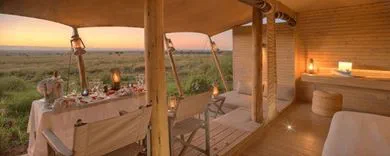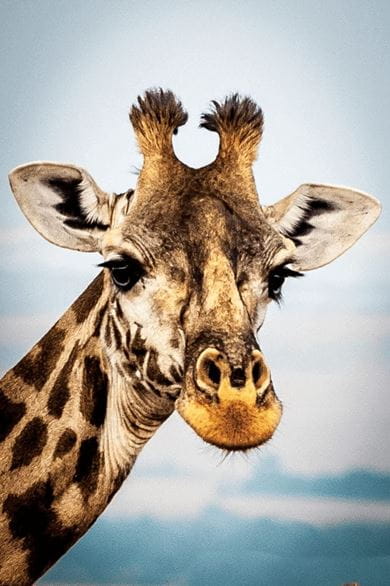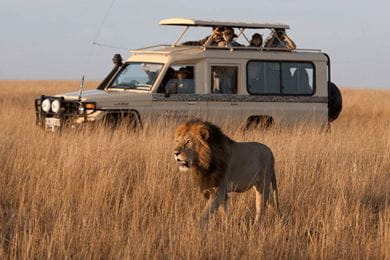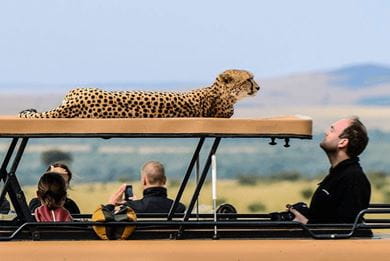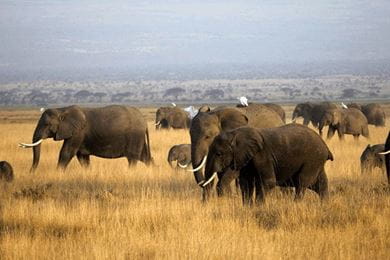







Majestic lions, magnificent wild elephants and an untouched, untainted landscape weaving together nature and culture – that’s East Africa for you
The sky always seems bigger in the Serengeti. The famed savannah in the middle of East Africa is so flat and so vast, and the visibility so clear, that the horizon line remains long and low all around you, appearing uninterrupted in the impossibly far distance for 360 degrees, almost until the curvature of the Earth causes the cracked, reddish-brown ground to fall from view.

To see the sky here at its biggest, however, you must sail above the savannah in a sunrise hot-air balloon ride, which is how I found myself experiencing it in the middle of a 12-day safari in Tanzania and Kenya. Feeling as much a part of the atmosphere as of the Earth, I floated in absolute silence — save for the occasional whoosh of the balloon’s flame, and the oohs and ahs of my 10 or so fellow travellers. The sky looked like a huge blue dome curling up and above us, its puffy white clouds receding into the distance in layers.
Below us, the show was just as impressive. Graceful impala bolted across the terrain, their shiny, golden coats showing off impressive musculature. A pair of topi — larger antelope cousins of the impala — practiced their fighting skills (perhaps to impress the females), knocking their short, ridged horns together. Warthogs, including several young, scurried along with their skinny little tails shooting straight up at the sky, like the flags on letterboxes. Ostriches pecked here and there, their poofs of plumes catching the morning light. But it was the herd of elephants that most impressed, a mix of females young and old, plus one so small we caught it nursing underneath its mother. The balloon pilot let us drift down lower, lower, closer, closer, until it felt like we could count the number of eyelashes on each elephant’s face. The great beasts turned their heads to look at us, flapping their massive ears forward in a show of dominance, and warning. And then whoosh — the pilot floated us up and out of harm’s way.
I’d come to East Africa for experiences just like this — to connect with nature and with the wild by seeing some of the world’s most impressive species up close and personal. Increasingly, they are also some of the most threatened of animals on the planet, as continued poaching in pursuit of ivory and skins, and destruction of habitat because of human encroachment reduces numbers greatly. Going to Africa right now feels vital, not just to see these creatures before it’s too late, but, more importantly, to travel with and support companies that make conservation a part of their missions.
To plan my trip, I turned to Micato Safaris, a second-generation, New York-based family-owned and operated high-end safari specialist that got its start 50 years ago in the Kenyan capital of Nairobi where its founders, Felix and Jane Pinto, still live and entertain the company’s guests. Thanks to its expertise, its command of logistics and its knowledge of the best of everything across the African continent, Micato has been named the #1 World’s Best Safari Outfitter an unprecedented nine times by the American magazine Travel + Leisure. It’s also a five-time winner of Conde Nast Traveler’s World Savers award, honoured for its partnerships with conservation organisations doing work on the continent and for the successes of its non-profit arm, AmericaShare.
When you travel with Micato, the adventure begins several weeks before departure. That’s when a large container arrived at my house, via UPS, stamped with the legend “Traveller’s Trove.” Inside, I found a green waterproof duffle bag to use for my trip — emblazoned with Micato’s logo and specially designed for the company by Marmot. Even more exciting was a metal-trimmed cardboard box containing safari documents wrapped in leopard-printed tissue paper: my professionally bound, lyrically written itinerary with full-colour photos; a recommended reading list; packing suggestions and more. I entertained myself for the next few hours by getting lost in the descriptions of what we’d do, what we’d see and where we’d stay, and then scrolling through Amazon to buy such required reading as Karen Blixen’s Out of Africa and Ernest Hemingway’s Green Hills of Africa.
For the Serengeti is the land of Blixen and Hemingway, of Maasai warriors and cattle herders, of the Great Migration of wildebeests and the predators that follow them. It’s the stuff of safari legend and also, arguably, the place where safari got its start. The region hasn’t always lived up to its promise, however. Overcrowding plagued national parks in Kenya and Tanzania, poachers threatened animals, and accommodations often proved more rustic than refined. Increasingly, however, private conservation concessions are becoming models of land stewardship, with lodges that are raising the hospitality bar while also providing smart ways for guests to engage with their surroundings. “Conservation and community have really become a focus,” says Dennis Pinto, Micato’s managing director and the son of its founders. “People see they’re part of the fabric of what happens, and they want to be part of the process. They want to get out and be in nature.” The itinerary his team put together would let me do just that.
My Micato trip took me from the Maasai Mara — what the Serengeti ecosystem is known as in Kenya — across the border into Tanzania, with stays at lodges and camps both within national parks and on private concessions on their outskirts. Doing so allowed me to appreciate the difference between the two types of reserve, like the ability to go on game drives after dark and to go off-road in a safari vehicle in the private areas. These were generally also less crowded and often limited the number
of jeeps that could show up at any given
animal sighting.
Throughout the trip, our group was led by Philip Rono, a Kenyan-born Serengeti veteran who acted as our safari director. Every Micato trip includes someone in this role: an expert guide who remains with you from the journey’s start to its finish, accompanying you from lodge to lodge, joining in the safari vehicles with the driver-guide from the camps to add his or her own knowledge. Thanks to Philip — whose easy laugh was infectious and whose deep gravelly voice made him sound like Louis Armstrong — within minutes of starting our first game drive, we happened upon a rocky outcropping where a pride of adult female lions and adolescents sunned themselves in the late-afternoon light. Cat napping in preparation for the evening’s hunt, they twitched flies away with their tails and whiskers, taking no notice of our arrival, though we were barely 6 metres away. Even when they did open their eyes, our presence didn’t faze them at all. “It’s like we are the ones in the cage now,” Philip remarked as the cats stared at us. “They look at us in this Jeep, and they wonder what we’re doing here.”
Each one of our twice-daily drives brought us impressive encounters like this, all of them paired with insights from Philip about animals’ eating, breeding and migrating habits, as well as about the security of their status in the Serengeti. (At one point, I asked how often rangers catch poachers and he said those statistics aren’t released — and the poachers aren’t either: “The rangers shoot on sight.”) Along the way, we learned about the importance of looking and listening and really lingering over the sightings, not giving in to the urban rat-race tendency to move on to the next thing as quickly as possible.
Listening, looking and lingering led us a few days later to a huge hippo we found out of the water and lumbering through the grass in the middle of the day — a rarity. She gave us a big open-mouth display of warning when we got too close, and then glided down an embankment into the river. Later in the day, we’d see an entire hippo family some six strong, running alongside another river before sliding one by one from the shore into the water, each one making a different sized splash.
On our final stop, at a private concession adjacent to Serengeti National Park in Tanzania, we spent an hour around sunset embraced by a massive herd of more than 100 elephants. With the engine cut, we could hear the animals’ footsteps and the sounds of their chomping away on grass and leaves as they grazed their way across the savannah. Then, driving back to the lodge, we made a detour to find a group of lion cubs and lionesses waking up from an afternoon slumber in the tall grasses. Though our day was ending, theirs was just starting. The hunt would soon be on.
The next day, going to sleep on our last night in the bush before heading back to Nairobi — where we’d meet the Pintos at their beautiful home and visit the education programmes Micato has established in the city’s slums — I was reminded of something I’d read in Hemingway’s Green Hills of Africa earlier in the trip: “All I wanted to do now was get back to Africa. We had not left it, yet, but when I would wake in the night I would lie, listening, homesick for it already.”
Nita Mukesh Ambani Cultural Centre brings to the city a vibrant space for the world of music, dance, ...
I sometimes feel as though the legacy of Lord Kitchener has pursued me all of my life. I studied his ...
In 1992, Prince Charles, the Prince of Wales and heir to the British Throne visited India along with ...
Should one risk a vacation in the middle of pandemic? I thought long and hard about it before decidi ...
The Mona Lisa traces back herself to her artist Leonardo da Vinci’s life at Château du Clos Lucé in ...
The Oberoi Beach Resort, Lombok has undergone rejuvenation and evolved into a destination of unrival ...
A vivid tour through the hottest Bree Street’s central reaches that we call home to the ethical food ...
The Oberoi Beach Resort, Sahl Hasheesh, offers a royal experience amidst the colourful sea life at E ...
Located at the junction of Aravali and Vindhya ranges, Ranthambhore National Park was once a private ...
William Shakespeare lived through one of the most turbulent yet thrilling era’s of English history ...
While central Melbourne has its own allure, the city’s charm lies in its diverse suburbs, each of wh ...
Adrian Rohnfelder, a photographer with a keen interest in volcanoes and adventure, shares his extrao ...
Witness the journey of a wooden instrument that broke all the records to become the backbone of Arab ...
To leap beyond imposed restrictive limits of existence is precisely what Dimpy Menon’s artworks spea ...
More than just a circus, Phare performers use theater, music, dance and modern circus arts to tell u ...
Peru is one of the peak experiences in travel. Nowhere on earth is there such an incredibly wide ran ...
The Oberoi Sukhvilas Spa Resort, New Chandigarh helps you get in touch with yourself so that you liv ...
The establishment of the British Empire greatly influenced the architecture and culture of India an ...
Complete with red sandstone fort, torch lit ramparts and ‘Haveli’ mansions, The Oberoi Rajvilās, Jai ...
Come aboard The Oberoi Zahra, Luxury Nile Cruiser for a delightful mix of luxury and history ...
The incredible Turtle Sanctuary at The Oberoi Beach Resort, Bali, is a must-visit for nature lovers ...
As part of the Beatles, arguably the most iconic rock band of all time, John Lennon and Paul McCartn ...
Oberoi Hotels & Resorts have won the hearts of many with its exquisite charm and glorious stays ...
When I work with a subject, whether it is landscape or nudes, I’m in a relationship with whatever’s ...
Portugal’s capital city of blues from the ubiquitous blue tiling adorning buildings to fado, the sou ...
My conceptual concerts initiate dialogue using various art forms. I wanted to produce works that are ...
From sticky toffee pudding and gastro pubs, to farmers markets, heritage farm meat and stalls housin ...
German art historian Sebastian Schütze, a creative master and precise in technique, captures the hum ...
The Italian art witnessed drastic movements in the period between 1850 to 1950, giving a platform fo ...
All associated with Mughal emperors, maharajas and their courts, the Al Thani Collection is a marvel ...
In the age of art as speculative and subjective, beauty can seem very much beside the point. But sta ...
Complex narratives are the peak of excitement for me. Narratives like double portraits provide stimu ...
At the helm of his eponymous brand, Fendi and Chanel, the late Karl Lagerfeld became as iconic as th ...
Essentially an attempt to replicate a beautiful representation on the canvas, I hope to convey the c ...
The Oberoi, New Delhi’s makeover is an inspiration of the contemporary interpretation of Sir Edward ...
An institution rather than a hotel, the glorious Oberoi Grand, Kolkata is the place tradition calls ...
Ginarte is a journey into beauty, a harmonic synthesis, an expression of strength and delicacy, a hy ...
Oberoi Hotels & Resorts has been ranked the world’s Best Hotel Group at the Telegraph Travel Awards ...
With more than 400 displays, Toward a Concrete Utopia: Architecture in Yugoslavia, 1948–1980, is the ...
Life of the royals in medieval England, especially the queens, was full of intrigue and scandal but ...
The Asian art scene, though young, is booming and art fairs continue to play a significant role in t ...
From ebonised Georgian bracket to 19th-century French brass carriage and the 21st-century Jaeger Le- ...
The East India Company was one of the most powerful commercial endeavours the world has ever seen, d ...
With more than 400 displays, Toward a Concrete Utopia: Architecture in Yugoslavia, 1948–1980, is the ...
The Oberoi Rajvilas, Jaipur offers an exemplary experience of luxury that transports you to the gold ...
Winner of “Middle East’s Leading Luxury City Hotel” for five consecutive years by the coveted World ...
With elegantly designed villas that offer the best of interiors to its patrons, The Oberoi Beach Res ...
On the north-west coast of Africa lies Casablanca, an ancient exotic land embraced in the sweeping s ...
The new uniforms adorning the staff at The Oberoi, New Delhi are a reflection of The Oberoi Group’s ...
Swan Lake, the iconic ballet composed by Pyotr Ilyich Tchaikovsky in the late 19th century, continue ...
The Buddha, in his many iterations across South Asia, is most exquisitely represented in gilt-bronze ...
At luxury watch brand Carl F Bucherer, design is about bringing together form and function to create ...
Queen, temptress, politician, murderer: Cleopatra remains an object of fascination for writers, arti ...
Go pedal-to-metal with the best track-ready cars unveiled at the 2018 Geneva Motor Show ...
With an enchanting combination of natural splendour, medieval heritage and modern luxury, The Oberoi ...
The Oberoi Udaivilas, Udaipur, brings together the finest in nature, luxury and impeccable service t ...
The Oberoi Amarvilas, Agra, has been voted the Top India Resort Hotel at the Travel + Leisure, USA W ...
Swiss Photographer Christian Tagliavini captures 15th and 16th-century courtly culture in a series o ...
As innovations in air travel bring the UK and Australia closer, the Kangaroo Route – once stretched ...
The Oberoi, Gurgaon offers a traveller more than just the opulence of a five-star hotel: it is a san ...
In the year 1936, legendary artist Henri Matisse executed with the utmost elegance a charcoal portra ...
The elegant suites at The Oberoi, Mumbai, provide an unrivalled experience of The Oberoi Group’s sig ...
The art collection of David and Peggy Rockefeller has garnered the highest total for any private col ...
The Oberoi Philae, Luxury Nile Cruiser takes you through the highlights of the Egyptian river on a s ...
Complementing its signature old-world charm with the finest of contemporary facilities, this Oberoi ...
Truly great experiences in life, are integral to a design sensibility that seeks to create a visual ...
Modern Indian cuisine is coming into its own, with pioneering Indian chefs like Vineet Bhatia, Gagga ...
Sailing along the River Nile aboard The Oberoi Zahra, Nile Cruiser, explore Egypt’s mystical tombs a ...
Late entertainer David Bowie’s art collection, recently auctioned by Sotheby’s, is an eclectic mix o ...
From Jean Paul Gaultier and Christian Dior to Emilio Pucci and Christian Louboutin, international fa ...
world are among the most highly coveted collectible antiques today ...
Home to the perfect confluence of nature and concrete, Al Zorah gives to luxury travellers the getaw ...
An institution rather than a hotel, the glorious Oberoi Grand, Kolkata is the place tradition calls ...
Combine the exhilaration of a jungle adventure with the relaxation of a luxurious retreat at this sp ...
From exotic varieties to beautiful native species, trees can transform your estate into your own sli ...
The East and the West might speak distinct design languages, but bring them together and a spectacul ...
In the land of the midnight sun, a quintessential family vacation is punctuated by a breathtaking ex ...
The misty Wuyi mountains in Fujian, China are home to Da Hong Pao tea, which can sell for more than ...
Award-winning architect Francis Kéré talks about his design journey and giving back to his homeland ...
In Milan, designer Arthur Arbesser and his associates work and play together, perhaps setting a temp ...
Magnates of the luxury world have been taking charitable steps into the world of European applied ar ...
The culinary offerings at The Oberoi Beach Resort, Al Zorah, reflect its vibe of simple sophisticati ...
The works of 18th-century chaser-gilder Pierre Gouthiere stand testimony to the aesthetic opulence o ...
The inner health of an organisation is as important as the external forces that influence its ascent ...
The artistic traditions of mounted porcelain and enamelling lend a whimsical air to some of the most ...
The finest works of literature can sometimes make for the finest works of cinema, and the list of fi ...
The iconic Victorian writer and social critic, seen through the eyes of his great-great-great grandd ...
Be a part of the legacy of turtle conservation on the island of Bali at this luxurious beachside hav ...
With impeccable culinary offerings, Mauritian archaeological heritage and the best location on the i ...
As The Oberoi, New Delhi revels in its newly reopened avatar, take a trip down memory lane and follo ...
Passion, craftsmanship and innovation are the defining aspects of Automobili Lamborghini’s design ae ...
As the universe of food undergoes a rapid transformation across the world, The Oberoi, New Delhi’s a ...
Fashion photography is about more than garments and labels - it is about penetrating the physical fo ...
With an artistic masterpiece by Sir Winston Churchill, The Goldfish Pool at Chartwell, recently goin ...
Balancing modernity with its centuries-old heritage, Amsterdam is a study in splendour and historica ...
Dance does not exist in a box and no rules must necessarily govern it. It is a thing of beauty, myst ...
Nestled within an impregnable valley, the “lost city” of Petra is a spectacular expression of cultur ...
Oberoi Hotels & Resorts has been ranked the world’s Best Hotel Group at the Telegraph Travel Awards ...
Ayurveda, natural healing and mindfulness together create a space of rejuvenation like no other at ...
Beginning in the national capital, make your way through these travel hotspots across India that ref ...
Leonardo da Vinci’s Salvator Mundi claimed a place in auction history recently, setting a new record ...
As the beacon of Western classical music continues to shine bright, a younger generation of musician ...
One fine April morning, 16 actors and technicians set out to take Shakespeare’s Hamlet around the wo ...
From gold snuff boxes inset with diamonds, amethysts and sapphires to ornately enamelled perfume fla ...
The written word, in conjunction with innovations, lies at the very heart of history, shaping cultu ...
August 1947: It had been more than a week since freedom had arrived and the country partitioned. But ...
The Biennale des Antiquaires culminated this year in stunning glory, only to cast its spell afresh n ...
Over the years, I must have observed and recorded the behaviour of at least 125 tigers in Ranthambho ...
The ancient science of Ayurveda tells you how best to enhance your beauty and nourish not only your ...
The gleaming, fluorescent-green topsides of the superyacht Inouï may scream luxury at the Maxi Yacht ...
The world is changing and it is not changing to the benefit of the manufacturers and retailers of so ...
This season, drive in style with these uber-luxurious four-wheeled debutantes ...
The phrase, ‘home is where the heart is’ acquired a new meaning for the children at SOS Children’s V ...
India’s finest private collections of classical Indian art mindfully preserve its creative heritage ...
Make memories last forever by taking your most cherished photographs beyond the frame and photo albu ...
With breathtaking views, luxurious rooms, rejuvenating spa therapies and a state-of-the-art golf cou ...
Seamlessly weaving together traditional elements of Indian architecture, aesthetically landscaped ga ...
Exquisite collectibles going under the hammer are letting connoisseurs acquire a little bit of histo ...
Coming to India in 1865 as the principal of an art school, John Lockwood Kipling made an invaluable ...
When travelling along the path of kings and queens, The Oberoi Hotels & Resorts offer a palatial pla ...
For luxury travellers, the sky is the limit, quite literally, as a gourmet open-air meal at the base ...
From 18th-century ormolu clocks framed by candelabra to enamelled 19th-century timepieces, mantel cl ...
The Emirate of Ajman is home to The Oberoi Beach Resort, Al Zorah, a modern architectural masterpiec ...
The last queen of France was a great commissioner of beautiful things, and several of the shops she ...
From exclusive garments manufactured in Italy to style inspirations drawn from art, this is what the ...
A new facet of Pablo Picasso’s artistic repertoire is taking over the international art market his c ...
Every bottle of vintage wine has a story to tell. We give you the narratives behind five of the fine ...
In the universe of Modern art, rivalry is a complex dynamic that enables one artist to be influenced ...
A story is conditional – it is a matter of perception and might not always be, subliminally or even ...
From unique water and land activities to certified diving courses, desert tours and more, this all-s ...
Enrich your stay in Ranthambhore at this opulent jungle resort, in close proximity to nature, yet ne ...
With performative nuances and provocative appeal, Western classical music has evolved into a complex ...







Second child until maximum age of 12 years will be accommodated in the same room at additional supplement. The additional amount is not included in the room price mentioned and shall be payable at the hotel during check-out.
400 AED (including tax)
250 AED (including tax)

